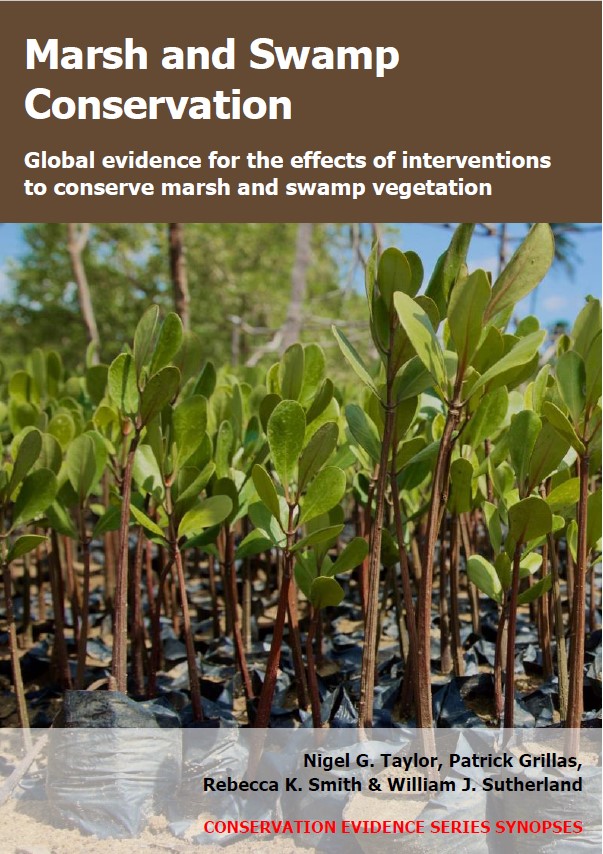Use grazing to maintain or restore disturbance: brackish/salt marshes
-
Overall effectiveness category Likely to be beneficial
-
Number of studies: 4
View assessment score
Hide assessment score
How is the evidence assessed?
-
Effectiveness
40% -
Certainty
46% -
Harms
10%
Study locations
Supporting evidence from individual studies
A replicated, controlled study in 1955–1957 in an estuarine salt marsh in England, UK (Ranwell 1961) reported that continued grazing reduced total vegetation biomass, but had mixed effects on the abundance of dominant plant species. Unless specified, statistical significance was not assessed. At the start of the experiment, total above-ground vegetation biomass was 8,061 g/m2. After two years, this was only 5,633 g/m2 in grazed plots, vs 7,118 g/m2 in ungrazed plots. Over two years, saltmarsh grass Puccinellia maritima biomass increased more in grazed plots (by 99%) than in ungrazed plots (by 80%). Saltmarsh grass cover significantly increased in four of four grazed plots, but did not significantly change in three of four ungrazed plots (data not reported). Cordgrass Spartina sp. biomass declined less in grazed plots (by 67%) than in ungrazed plots (by 97%). Saltbush Atriplex hastata biomass declined more in grazed plots (by 277%) than in ungrazed plots (by 70%). Cover of these species typically declined significantly in both grazed and ungrazed plots. Methods: In summer 1955, eight 9 x 13 m plots were established in a historically grazed salt marsh. Four plots continued to be grazed by sheep during summer (average 24 sheep days/plot/year). Four plots were fenced to exclude sheep. Vegetation was surveyed in early June at the start of the experiment (1955) and over the two following years (1956–1957). Biomass was dried before weighing.
Study and other actions testedA controlled study in 1972–1978 in a salt marsh in Denmark (Jensen 1985) reported that an area in which grazing was maintained had identical plant species richness to an area from which livestock were excluded, but had lower vegetation cover. Statistical significance was not assessed. After approximately six years, the same seven plant species were present in the grazed and exclusion areas. However, six of these species had lower cover in both grazed plots – including saltmarsh grass Puccinellia maritima (grazed: 72–82%; exclusion: 84–92%) and sea purslane Halimione portulacoides (grazed: <1%; exclusion: 8–17%). Accordingly, both sampling plots within the grazed area had lower overall vegetation cover than both sampling plots within the exclusion area. This was true for cover including overlapping vegetation (grazed: 81–89%; exclusion: 130–145%) and for cover as the inverse of bare ground (grazed: 73–83%; exclusion: 95–98%). Methods: In spring 1972, an area of historically grazed coastal salt marsh was fenced to exclude livestock. Grazing was continued in the rest of the salt marsh (with at least 0.5 sheep/ha and 0.5 cattle/ha, May–October). In August 1978, the cover of every plant species and bare ground were recorded in two plots in the grazed and exclusion areas (50 point quadrats with 10 pins/plot).
Study and other actions testedA replicated, paired, controlled, before-and-after study in 1989–1994 of eighteen brackish marshes in southern France (Mesléard et al. 1999) reported that the effects of continued grazing on plant community composition, abundance and species richness depended on the flooding regime. Unless specified, statistical significance was not assessed. Under all three flooding regimes, the overall plant community composition in grazed and ungrazed plots diverged over five years. However, the speed and direction of the changes depended on the flooding regime (data reported as graphical analyses). For example, under two artificial flooding regimes, grazing significantly reduced the final cover of sea club rush Bolboschoenus maritimus (grazed: 11–12%; ungrazed: 31–33%) and common reed Phragmites australis (grazed: <1%; ungrazed: 12–16%). Other species showed mixed responses to grazing depending on the season of artificial flooding (see original paper). After five years, total plant species richness was lower in grazed fields under artificial flooding regimes (grazed: 4 species/0.25 m2; ungrazed: 5–6 species/0.25 m2) but higher in grazed fields under an unmanaged flooding regime (grazed: 7 species/0.25 m2; ungrazed: 5 species/0.25 m2). Methods: The study used two sets of nine inland brackish marshes (former rice fields, but grazed since 1976 when cultivation stopped). In November 1989, one set was fenced to exclude livestock. The other set remained grazed (approximately 2 cattle and 1 horse/ha, April–November). Three of the nine 1-ha marshes within each set received each flooding regime: artificial winter flooding, artificial summer flooding, or year-round unmanaged flooding. Vegetation was surveyed every six months from early November 1989 to early November 1994 (nine 0.5 x 0.5 m quadrats/field/
Study and other actions tested
survey).A replicated, randomized, paired, controlled, before-and-after study in 1998–2000 in ephemeral alkali marshes around one lake in Idaho, USA (Austin et al. 2007) found that grazing had no significant effect on vegetation biomass. After both one and two years, changes in live above-ground plant biomass were statistically similar in grazed plots (non-significant change of <40 g/m2 from before to after intervention) and ungrazed plots (non-significant change of <100 g/m2 from before to after intervention). Methods: Three sets of three fields with similar neighbouring vegetation were studied. Each field contained a range of wetland habitats, including alkali flats (seasonally flooded; developed salt crust in summer). All fields had been historically grazed and cut, but were undisturbed from 1996. Three fields (one random field/set) received each treatment: annual autumn grazing (September–October 1998 and 1999), one-off summer grazing (July–August 1998) or no grazing. Grazing intensity was 2.3–2.5 animal unit months/ha (one AUM is the amount of feed required to sustain a 1,000-lb cow and her calf for one month). Vegetation was surveyed in June–July before intervention (1998) and for two years after (1999, 2000).
Study and other actions tested
Where has this evidence come from?
List of journals searched by synopsis
All the journals searched for all synopses
This Action forms part of the Action Synopsis:
Marsh and Swamp Conservation
Marsh and Swamp Conservation - Published 2021
Marsh and Swamp Synopsis





)_2023.JPG)














